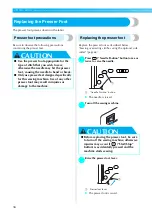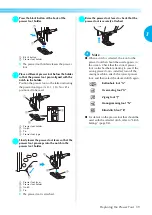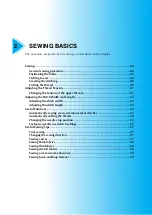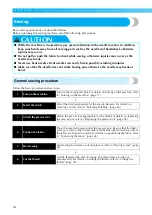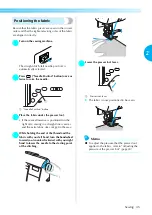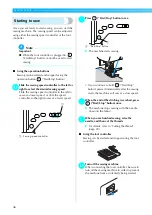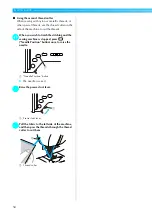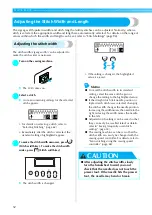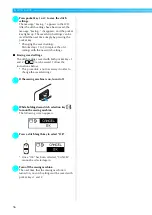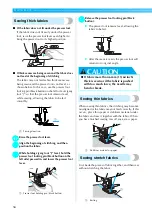
SEWING BASICS
— — — — — — — — — — — — — — — — — — — — — — — — — — — — — — — — — — — — — — — — — — — — —
44
Sewing
Basic sewing operations are described below.
Before operating the sewing machine, read the following precautions.
CAUTION
General sewing procedure
Follow the basic procedures below to sew.
↓
↓
↓
↓
↓
●
While the machine is in operation, pay special attention to the needle location. In addition,
keep your hands away from all moving parts such as the needle and handwheel, otherwise
injuries may occur.
●
Do not pull or push the fabric too hard while sewing, otherwise injuries may occur or the
needle may break.
●
Never use bent needles. Bent needles can easily break, possibly resulting in injuries.
●
Make sure that the needle does not strike basting pins, otherwise the needle may break or
bend.
1
Turn on the machine.
Turn on the sewing machine.For details on turning on the machine, refer
to “Turning on the machine” (page 17).
2
Select the stitch.
Select the stitch appropriate for the area to be sewn.For details on
selecting a stitch, refer to “Selecting Stitching” (page 62).
3
Attach the presser foot.
Attach the presser foot appropriate for the stitch.For details on replacing
the presser foot, refer to “Replacing the presser foot” (page 38).
4
Position the fabric.
Place the area to be sewn under the presser foot. Be sure that the fabric
pieces are sewn in the correct order and that the right and wrong sides of
the fabric are aligned correctly.For details on positioning the fabric, refer
to “Positioning the fabric” (page 45).
5
Start sewing.
Start sewing.For details on starting to sew, refer to “Starting to sew” (page
46).
6
Cut the thread.
Cut the thread at the end of sewing. The thread may also be cut
automatically.For details on cutting the thread, refer to “Cutting the
thread” (page 49).
Summary of Contents for 885-U26
Page 2: ......
Page 16: ...14 ...
Page 62: ...SEWING BASICS 60 ...
Page 122: ......
Page 123: ......









